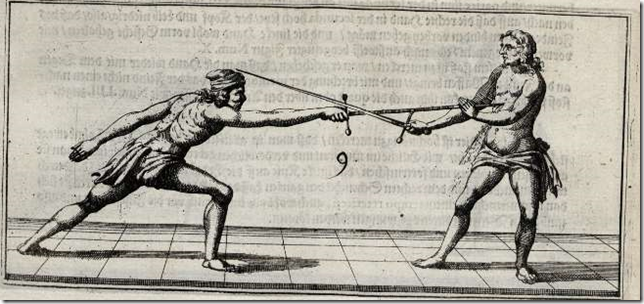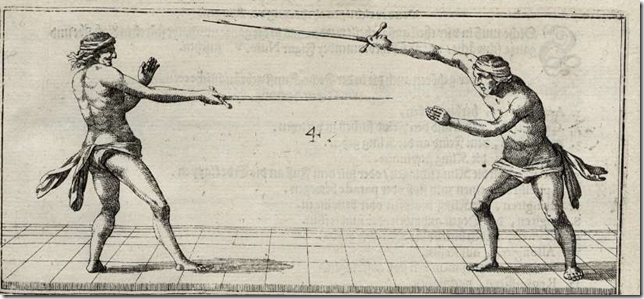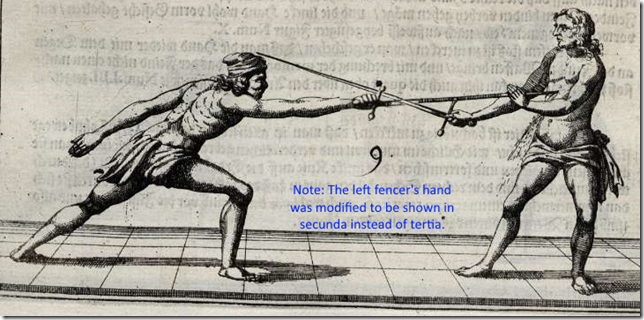The third thrust in chapter 7 is giving my group quite a bit of trouble. The beginning is easy enough. If you are on the inside and the opponent parries in quarta, then you should disengage while gathering your front foot back. You can then thrust in tertia over the opponent’s right arm as shown in illustration 9.
Important Takeaways
In my opinion, the most important thing to learn from this drill is the gathering step during the disengage. Other authors such as Capoferro spend countless pages reminding the reader to withdraw the body when disengaging lest you be offended during said disengage.
Problems with the Hand
Lets take a close-up of that hand.
The opponent’s blade is awfully close to our fencer’s hand. And in drilling it isn’t uncommon to have it touch or even slice our fencer.
Now the text does say that I can turn my fist “a little towards towards secunda” but what does that mean? If I just rotate my hand out slightly, it seems to make matters worse. So we’ve started speculating…
Maybe the Guards are More Complex
This illustration shows a small shell in front of the quillons. This wouldn’t offer a lot of protection, but perhaps it is enough to save the hand.
Under this theory, the simple guards we see in most illustrations are just training weapons and the real ones would have the smallsword like hilt see in illustration 5.
Maybe the Illustration is Wrong and the Hand Should be Inverted
I hate resorting to this argument and would only do so in the most extreme cases. But that said, there is a possibility.
In illustration 4, we see secunda with the hand inverted almost into prima.
Some fencers in my club report that they can invert their hand into this position during the 3rd thrust in such a way that their hand is no longer at risk from the opponent’s blade. It looks something like this:
In the illustration above, I pasted a secunda hand rotation from illustration 10.
Maybe the Illustration is Correct, but the Text is Offering the Inverted Hand as a Variant
This makes me feel a bit better. Under this theory you can thrust with the true edge down, but if necessary you can turn your hand over into secunda without raising the hilt. The text isn’t clear enough to say for certain this is a correct interpretation, but it isn’t clear enough for me to say its wrong either. And it eliminates the “illustration is wrong” conceit that bothers me to much.
Maybe the Edges are Not Sharp
Matt Easton recently did a presentation on the Transition from rapier to smallsword. This has me thinking that perhaps the edges were not sharp. Consider these facts:
- Most smallswords couldn’t cut
- L’Agne doesn’t mention cuts (or least I haven’t seen one yet)
- L’Ange only uses the term “rapier” once. The rest of the time he uses the word “degen”, which the translator says means “sword” or “fencing sword”.
- Depending on the location and time period, a smallsword could be called a rapier
- During the transitional period, it would not be unthinkable for some people to be using a thinner, smallsword like blade that couldn’t cut but is still be quite long.
- L’Ange shows far more work with the off-hand than I’ve seen in any rapier text that uses the occasional cut.
Given all this, I wouldn’t be surprised to learn that L’Ange is teaching a weapon without a sharp edge. Or at least not an edge that close to the hilt.
Maybe I’m Wearing Gloves
The illustrations show nearly nude fencers, but that clearly most fights would involve the wearing of clothing. If that included gloves, then perhaps it was enough protection against incidental cuts that this isn’t a valid concern.
If we take it a step further, we could be using chainmail gloves. We know that they existed during that time period and were designed so that your entire left hand, and the back of your right hand, were well protected from slices.
Maybe I Just Don’t Care About Incidental Cuts
If your life is in danger, perhaps you are willing to accept a cut to the hand in exchange for a thrust through the lung.
Conclusion
Um, no. I’m leaving this as an open question until we’ve worked through more of the text.







Reinier van Noort
This may or may not help. Your point regarding the weapon is likely valid, in that the lack of guard is for a training weapon. (See also Liancour, I believe).
In thrusting (or engaging) on the outside, try not pushing your hand outwards, but keeping it central on the line. Let your point go out instead. Push your blade over rather than along his, so that you push his blade down and to your right.
For these later/German rapier styles, I get the impression most things work very well (or better) if you keep your hand on the centre line and let the blade (point) do most of the moving.
Reinier van Noort
In this case, rotating from tertia to secunda (a little) should not use the shoulder (I think). Think turning a key.
EnsisSubCaelo
There is a mostly identical technique in Fabris, plate 22 (you can read the original text on the previous page ). It shows the same hand position with a mostly vertical cross. It seems more likely to be safe if the opponent is really trying to parry the blade and not just hang there and drop his edge on your hand.
Indeed complex hilts nicely protect in this situation. The vast majority of original sharps from the period seem to have them. In training it is possible to neglect incidental hits to the hand that would be blocked by the features of the corresponding sharp, as is done in Katori Shinto ryu which uses boken without a handguard at all. I don’t think mail gloves are a likely solution; the ones I’ve seen have mail on the palm and are meant for the left hand.